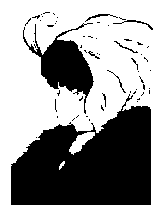The individual
perceives the environment as a total unit; he/she responds
to the whole of what is seen and this whole is composed of the stimuli
of which the person is aware or to which he/she attends,
the "spontaneous concentration" of contact (the
figure) and those of which the person is not aware or does not attend (the
ground). The figure/ground process
is perceptual and changes momentarily.
Study, for example, the classic Gestalt perceptual picture at right.
Two persons can be perceived, an old woman and a young woman.
When the old woman is figural all the rest of the picture is ground;
when the young woman is figural the old woman disappears into the ground.
As you study the picture you may be able to change your perceptions from
one figure to the other in order to appreciate the process of emerging
figures and receding grounds as it occurs in your everyday life.
To arbitrarily change one's focus is an experiment in perception.
However, in a life situation such a change in perceptual focus represents
more than a trick of the eye. The perception of a figure emerging
from the ground is a consequence of an internal choice that, although momentary,
involves a complex of internal processes. In the internal world,
personal needs, values, beliefs, etc. provide the impetus for the choice
of figure; the choice also is powered by the search for meaning,
a search that is endemic in each human being. In Gestalt theory,
the meaning connected with a figure is a critical aspect of its relation
to the ground at that moment. Thus, if at the first look at
the above illustration you perceive the young woman, your choice of that
perceptional target may relate to some personal experience, favorable or
difficult, with young women or some negative experience with old women.
These relationships have been accumulated in the ground of your experience;
for you, the meaning of the figural young woman is derived from the connections
you have had with women. Some similar analysis could be made
if you perceive the old woman first. Whether the viewer notices
the old or the young is related meaningfully to the ground of the viewer's
experience which is a rich mix of all of the past experiences of the self,
the world, and their myriad interactions plus the feelings, beliefs, values
and the needs that are embedded in the internal world. The
ground defines the figure and gives it meaning.
To change the figure, whether in awareness or not,
involves a complex set of internal changes. These are always
in process. I sit at my desk as I
write; at one moment I am aware of thinking, at the next of
the feel of the pen in my hand, at the next of seeing a set of papers that
remind me of other tasks I need to perform, and again I am aware of thinking
about this material on figure and ground. On the unaware level
in my body the figures have been relating to my internal
processes
and at once I am aware of being hungry.
The context changes to choices about actions. Such perceptual
changes are a potent aspect of any therapeutic interaction as well.
The client's figural process must be followed and the therapist's figural
process must be honored also. The art of Gestalt therapy comes
into play with this scene in which the therapist must attend to both the
client's figural process and to his or her own.
 Alternative illustrations of figure/ground relationships may be seen in
the classic Gestalt "Vase/Faces" picture on the left, or from this example
offered in the Korb et al 1989 book:
as you read this material note that the margins and spaces between letters
and pictures on the printed pages help to define the words, sentences and
pictures. If there were no margins and spaces it would be difficult
to distinguish what has been written. Although the white margins
are blank spaces they do not have blank functions—they are integral to
the perceptions of the words.
Alternative illustrations of figure/ground relationships may be seen in
the classic Gestalt "Vase/Faces" picture on the left, or from this example
offered in the Korb et al 1989 book:
as you read this material note that the margins and spaces between letters
and pictures on the printed pages help to define the words, sentences and
pictures. If there were no margins and spaces it would be difficult
to distinguish what has been written. Although the white margins
are blank spaces they do not have blank functions—they are integral to
the perceptions of the words.
Likewise, all figural information, whether visual, physical, semantic,
emotional, or interpersonal, is gained by relating a figure meaningfully
to the field of impressions against which it is perceived, the ground.

 Alternative illustrations of figure/ground relationships may be seen in
the classic Gestalt "Vase/Faces" picture on the left, or from this example
offered in the
Alternative illustrations of figure/ground relationships may be seen in
the classic Gestalt "Vase/Faces" picture on the left, or from this example
offered in the